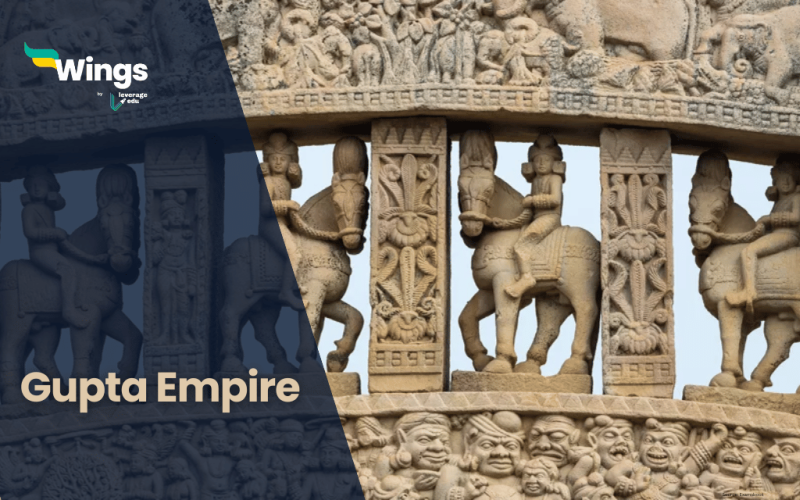The Gupta Empire was a great kingdom from the 4th century CE to the late 6th century CE. This dynasty covered almost all of the Indian subcontinent at a time that became known as the ‘Golden Age’ for India. It was because of the developments in poetry, prose, and drama as well as in mathematics and astronomy. There were various important discoveries made in these fields. It is not very hard to realise this though as the famous literary marvel Kalidasa and the great mathematician Aryabhatta blessed our country during this time only.
Table of Contents

Also Read: Samudragupta – The Indian Napolean
Origins of Gupta Empire
The origins and familial lineage of the Gupta Empire are vague. Nevertheless, according to popular belief, they belonged to the Vaishya caste. However, they are still believed to have originated from modern-day Uttar Pradesh, then a region of Magadha. It is also believed that the Puranas were developed during this time. However, these texts are compiled over centuries and were transformed before and even after the Gupta empire.
The Guptas gained massive influence and control over northern India by the Fourth century CE. Also, the knowledge of the early Gupta period only came from the Buddhist monks who travelled along the region. The grace of the Gupta empire began at the time of Chandragupta I. Moreover, it was Samudragupta who is known to have expanded the kingdom at large.

Also Read: Magadha Empire: Rise, Dynasties, Rulers & Decline
Important Rulers
Here are some of the important rulers of the Gupta Dynasty. The names are given in order of succession.
| Ruler | Contribution |
| Sri Hari Gupta240-280 CE | Founded the Gupta Empire |
| Ghatotkathch280-319 CE | Successor of Sri Hari Gupta. |
| Chandragupta I 320–330 CE | He was titled the Maharajadhiraja’ which means the king of kings. Firmed alliances with kingdoms by marrying princess Kumardevi |
| Samudragupta330-380 CE | Inscriptions about Samudragupta have been carved on the Allahabad pillar. He unified a major part of northern India politically. He came to be known as the Napoleon of India. |
| Chandragupta II ‘Vikramaditya’380-414 CE | He also expanded the Gupta Empire through marriage, alliances and military expeditions. He shifted the capital to Ujjain and also annexed the Sakas of Malwa, Gujarat, and Saurashtra. Fa Hien visited India during this time and Kalidasa was one of his courtiers. |
| Kumaragupta-I 415-455 CE | He laid the foundation of Nalanda University. He was also known for his unique Rhino coins. |
| Skandagupta 455- 467 CE | He was the last ruler of this dynasty. Second invasions from the Hunas came during this time, he defeated them but the empire was economically weakened. |

Also Read: Pala Dynasty: Rise, Rulers, Administration & Decline
Administration
There are detailed accounts of travellers on the administration and economy of the Gupta Empire. Here are some of the features that one cannot overlook while studying about the dynasty.
- The form of government was Monarchy and each ruler established their own council called the Mantri Parishad.
- Kumaramatya and the Sandhivigrahika were the high officials in the council.
- The whole empire was divided into provinces for better governance. These provinces were called Bhuktis.
- Each Bhukti was further divided into ‘Vishyas’. Furthermore, Bhuktis were governed by a Uparika appointed by the king.
- Vishyas were under the Vishayapatis who were either appointed by the provincial council or the king.
- Their management and governance operated from the grassroots levels.
Also Read – Chera Dynasty: Kings, Administration, Religion & Conquests
Are Mauryas and Guptas the Same?
No, the Mauryas are not the same as Guptas. The Mauryan empire came much earlier than the Guptas and established their rule over Magadha. The area where both dynasties started ruling was Magadha and their first capital was Patliputra. This creates a lot of confusion between the histories of the two empires. The early rulers like Samudraguta and Chandragupta were the same in both dynasties. The Mauryan empire was founded by Chandragupta Maurya and the first and most influential ruler of the Gupta dynasty was also Chandragupta. Similarly, both dynasties saw a major expansion of empires during the reign of rulers named Samudragupta. However, the two are dynasties and these rulers with the same names are entirely different.
Relevant Blogs
| Maratha Empire (1674-1818) | Satavahana Dynasty |
| The Vijaynagar Empire (1336-1647) AD | Pallava Dynasty |
| Khilji Dynasty (1290–1320) | Lodi Dynasty |
| Sunga Dynasty | Chola Dynasty |
| Kushan Dynasty | Chalukya Dynasty |
That’s all about the Gupta Empire! If you want to know more about topics like this, then visit our general knowledge page! Alternatively, you can also read our blog on general knowledge for competitive exams!
 One app for all your study abroad needs
One app for all your study abroad needs













